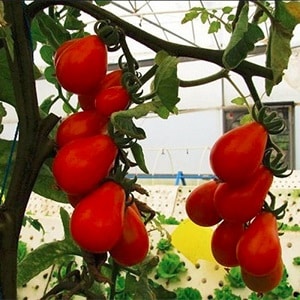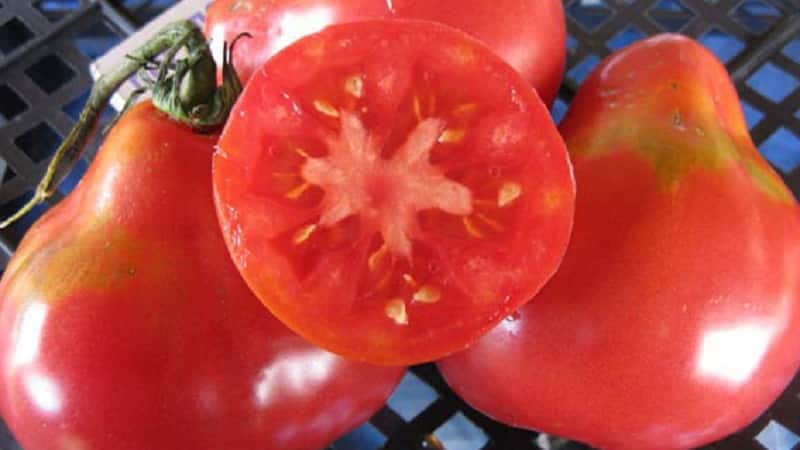Distinctive characteristics of the fruits of the tomato variety “Pink Pear”
Pink pear is a popular tomato variety that has excellent taste and is relatively easy to grow. Tomatoes attract summer residents with their unusual shape and good yield. These vegetables are cultivated both in greenhouses and in open ground, and even on the balcony in flower pots. The Pear tomato variety will decorate the garden bed and delight the owner with healthy fruits.
Characteristics and description of the tomato variety
The variety was bred through high-quality selection of Pink Giant tomato seeds. In regions with cool climates, pears are grown in greenhouse conditions. In the southern regions of the country, tomato is cultivated in open ground.

The bush reaches a height of 1.3 m, but in greenhouse conditions the crop grows up to 1.7 m. From the moment of planting to the harvest of the first harvest, 105-115 days pass. The variety shows good yield if the pear is formed into one stem. The plant needs pinching and tying the bush to a support.
Distinctive characteristics of the fruit
Dense, fleshy tomatoes have a smooth shell. The shape of the fruit resembles a pear. The color of the vegetables is deep pink. When growing the variety in open ground, the weight of one tomato reaches 50 g, in greenhouse conditions - up to 75 g. Up to 11 kg of crop is harvested from one square meter if there are no more than 4 bushes on it.
The variety is universal in use. Tomatoes are used to make juice, sauce, and adjika. Tomatoes are also great for winter preparations.
On a note. Due to their excellent taste and good presentation, tomatoes are successfully sold in markets and grocery stores.
Pros and cons of the variety
 Pink pear variety has a number of positive characteristics:
Pink pear variety has a number of positive characteristics:
- excellent taste;
- versatility in application;
- original appearance;
- good transportability;
- high productivity;
- the same size and weight of the fruit;
- strong immunity to diseases.
Disadvantages of the variety:
- the bush must be constantly tied up;
- culture needs stepsoning;
- roots crack if there is insufficient moisture.
Other varieties of pink tomatoes:
A bright and tasty decoration for your site - “Monisto pink”
How to grow seedlings
Work with seedlings is carried out in several stages:
- High-quality seed material is obtained from the ripest and largest fruits. The tomato pulp and grains are kneaded, and after 3 days they are washed in a sieve with running water and dried on a sheet of paper.
- Before sowing, the seeds are treated. The grains are placed for 20-30 minutes in a 1% solution of potassium permanganate, then washed with running water and placed in growth stimulants for a day. To increase the crop's resistance to low temperatures, the seeds are placed in the refrigerator for 1 day.
- Next, prepare the soil for seedlings. You can purchase a ready-made soil mixture for vegetable plants in a store or make it yourself by mixing humus, peat and turf soil in equal parts. This substrate is perfect for growing seedlings.
- For cultivating tomatoes in greenhouse conditions, seeds are sown for seedlings in early March, and for growing outdoors - at the end of the month.
- Any container or special container is filled with soil. The seeds are deepened into the soil by 1.5-2 cm. The soil is carefully moistened so as not to wash away the top layer of soil. A sprayer is used for this. The container is covered with plastic wrap or transparent glass and placed in a warm place.
- Shoots appear within a week and are watered regularly. After another seven days, real leaves grow.
- When the plants have two leaves, the seedlings are planted in large boxes at a distance of 10x10 cm from each other. At the same time, the plants are deepened to the cotyledon leaves.
- The next transplant is carried out after 14 days. To do this, each plant, together with a lump of earth, is placed in separate containers of at least 1 liter. Peat cups are most often used.
- During the period of growing seedlings, the plants are fed twice. For this purpose, complex fertilizers (“Nitroammofoska”) are used.
- Two weeks before planting seedlings in a permanent place of growth, the plants are hardened. To do this, the bushes are taken outside or onto the balcony for a couple of hours. The time spent by tomatoes in the fresh air is gradually increased.
Properly prepared seedlings will ensure a good harvest and the opportunity to collect seeds for next year.
On a note. By the time the plants are planted in the ground, the bushes should be no more than 30 cm in height.
Landing rules
Seedlings are planted in an unheated greenhouse in May, in open ground - in June. Plants are planted at a distance of 40 cm from each other, and at least 50 cm between rows. The best predecessors for tomatoes are legumes, radishes, carrots or cabbage.
Choose a well-lit bed. With a lack of light, the culture will not fully develop.The Pink Pear variety does not tolerate temperature drops below +15 C° or increases above +35 C°. In hot weather, the pollination process is disrupted and ovaries do not form. At low temperatures, flowering and fruit set stop, plants begin to suffer from late blight, which makes the fruits unfit for consumption.
Care
 Plants are watered regularly, preventing the soil from drying out., but excessive moisture also has a bad effect on the culture. The procedure is performed in the morning or evening, when the sun is not shining. Use settled or rainwater at room temperature. The bushes are moistened at the root. After watering, the soil around the bushes must be loosened and weeds removed. Plants are also pinched. These measures improve ventilation, which helps remove excess moisture from the soil.
Plants are watered regularly, preventing the soil from drying out., but excessive moisture also has a bad effect on the culture. The procedure is performed in the morning or evening, when the sun is not shining. Use settled or rainwater at room temperature. The bushes are moistened at the root. After watering, the soil around the bushes must be loosened and weeds removed. Plants are also pinched. These measures improve ventilation, which helps remove excess moisture from the soil.
To obtain a good harvest throughout the growing season Fertilizers are applied once every three weeks. Organic and mineral fertilizers alternate. They try not to use manure, as it promotes the growth of foliage and weeds, which in turn slows down the development of fruits.
The bush is formed into one or two stems – this is quite enough to achieve a bountiful tomato harvest. Experienced gardeners leave no more than 8 trusses on the plant.
On a note. Tomatoes contain a large amount of serotonin (the hormone of happiness), so this wonderful product can lift your spirits just as well as chocolate.
Seedless growing method
 Tomato is picky about soil. The soil must be fertile and loose. In order for the land to meet these requirements, before planting it is dug up and fertilized with phosphorus, potassium and wood ash.
Tomato is picky about soil. The soil must be fertile and loose. In order for the land to meet these requirements, before planting it is dug up and fertilized with phosphorus, potassium and wood ash.
Fertilizing is applied simultaneously with diggingso that minerals reach the lower layers of the soil.
Planting scheme:
- The seeds are sown in such a way that there is a distance of about 40 cm between them. Thickening is not allowed, as it will lead to a decrease in yield or plant disease.
- After planting the seeds, the bed is watered with warm water. If planting is done in open ground, cover the top with film or lutrasil. This will protect the seedlings from possible cold snaps.
Read also:
Prevention of diseases and pests
If there is not enough magnesium and potassium in the soil, white rot affects the crop. Tomatoes in greenhouses are often infected with this disease due to their proximity to other vegetable crops. When the disease appears, all rotten shoots are destroyed or the entire bush is removed.
To protect crops from viral and fungal diseases At the beginning of growth, tomatoes are watered with a weak solution of potassium permanganate. The Colorado potato beetle is destroyed by treating the bushes with chemicals - “Karate”, “Bankol” or “Killer”. To prevent caterpillars, slugs and other crawling pests, sprinkle the roots of the bushes with wood ash or copper sulfate.
Important! A month before harvesting tomatoes, spraying with chemicals is stopped.
Reviews from gardeners
Reviews from gardeners about Pear yields are mostly positive.
Nadezhda, Abakan: “Last year I tried to grow the Pink Pear tomato variety for the first time. I bought several packages of Pink and Orange pear seeds. I grew tomatoes in greenhouse conditions. Spring comes late for us, so I transplanted seedlings into closed ground at the beginning of June. All the seeds sprouted and the young plants developed well.I didn't pay much attention to tomatoes. I really liked the shape of the fruit, it’s just like in the photo of the packaging. The tomatoes taste great. The variety turned out to be quite productive. There were enough tomatoes for both food and canning. Pear has now become one of my favorite varieties. Next time I’ll try to grow red and black Pear.”.

Dmitry, Novgorod: “The salesperson at the gardening store advised me to buy pink pear tomato seeds. Since our climate is cool, the variety was grown in a greenhouse. I applied fertilizer 4 times. I collected a lot of harvest from 15 bushes. The tomatoes taste good and last a long time. I tried to pick unripe tomatoes. They ripened on the windowsill, but they weren’t very sweet. I liked the variety".
Vladimir, Engels: “I have been involved in vegetable growing for about 10 years. I grew pink pear for 2 years in a row. The tomatoes are tasty and meaty. My wife makes canned food and ketchup from them. The plants did not get sick. No more hassle than with other varieties. I fertilized the crop only twice per season. From one bush I collected about 4 kg of crop. The grandchildren liked the tomatoes; they picked them from the bush, washed them and ate them right away. Next year I will plant again".
Conclusion
The Pink Pear variety has an original appearance of the fruit and a pleasant taste. The tomatoes are the same in weight and size, the structure is dense. The culture has good immunity to diseases. The fruits tolerate transportation well and are stored for a long time. This vegetable also contains many vitamins and perfectly decorates the garden bed.